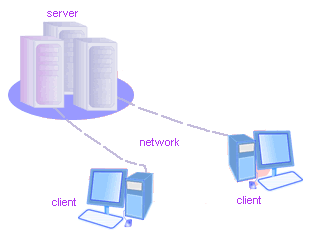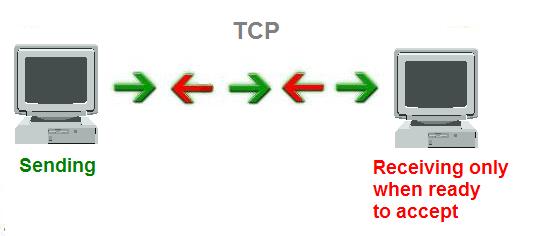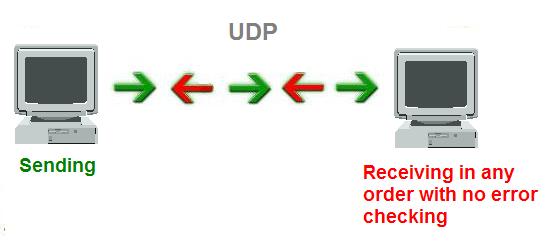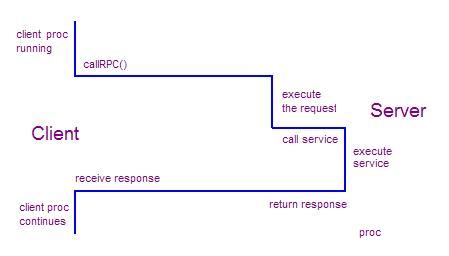"Introduction to Distributed System Design"
Note
O. Tatebe, "Introduction to Distributed System Design"
The Basics
What is a distributed system?
Here is a "cascading" definition of a distributed system:
- A program: is the code you write.
- A process: is what you get when you run it.
- A message: is used to communicate between processes.
- A packet: is a fragment of a message that might travel on a wire.
- A protocol: is a formal description of message formats and the rules that two processes must follow in order to exchange those messages.
- A network: is the infrastructure that links computers, workstations, terminals, servers, etc. It consists of routers which are connected by communication links.
- A component: can be a process or any piece of hardware required to run a process, support communications between processes, store data, etc.
- A distributed system: is an application that executes a collection of protocols to coordinate the actions of multiple processes on a network, such that all components cooperate together to perform a single or small set of related tasks.
Why build a distributed system?
There are lots of advantages including the ability to connect remote users with remote resources in an open and scalable way.
- open: each component is continually open to interaction with other components.
- scalable: the system can easily be altered to accommodate changes in the number of users, resources and computing entities.
How can a distributed system be reliable?
For a distributed system to be useful, it must be reliable. To be truly reliable, a distributed system must have the following characteristics:
- Fault-Tolerant: It can recover from component failures without performing incorrect actions.
- Highly Available: It can restore operations, permitting it to resume providing services even when some components have failed.
- Recoverable: Failed components can restart themselves and rejoin the system, after the cause of failure has been repaired.
- Consistent: The system can coordinate actions by multiple components often in the presence of concurrency and failure. This underlies the ability of a distributed system to act like a non-distributed system.
- Scalable: It can operate correctly even as some aspect of the system is scaled to a larger size. For example, we might increase the size of the network on which the system is running. This increases the frequency of network outages and could degrade a "non-scalable" system. Similarly, we might increase the number of users or servers, or overall load on the system. In a scalable system, this should not have a significant effect.
- Predictable Performance: The ability to provide desired responsiveness in a timely manner.
- Secure: The system authenticates access to data and services.
Category of failures in a distributed system
When you design distributed systems, you have to say, "Failure happens all the time." So when you design, you design for failure. It is your number one concern. Failures fall into two obvious categories: hardware and software.
- Hardware failures: today, problems are most often associated with connections and mechanical devices, i.e., network failures and drive failures.
-
Software failures: residual bugs in mature systems can be classified into two main categories
- Heisenbug: A bug that seems to disappear or alter its characteristics when it is observed or researched. A common example is a bug that occurs in a release-mode compile of a program, but not when researched under debug-mode.
- Bohrbug: A bug (named after the Bohr atom model) that, in contrast to a heisenbug, does not disappear or alter its characteristics when it is researched. A Bohrbug typically manifests itself reliably under a well-defined set of conditions.
Heisenbugs tend to be more prevalent in distributed systems than in local systems. One reason for this is the difficulty programmers have in obtaining a coherent and comprehensive view of the interactions of concurrent processes.
The types of failures that can occur in a distributed system:
- Halting failures: A component simply stops. There is no way to detect the failure except by timeout: it either stops sending "I'm alive" (heartbeat) messages or fails to respond to requests. Your computer freezing is a halting failure.
- Fail-stop: A halting failure with some kind of notification to other components. A network file server telling its clients it is about to go down is a fail-stop.
- Omission failures: Failure to send/receive messages primarily due to lack of buffering space, which causes a message to be discarded with no notification to either the sender or receiver. This can happen when routers become overloaded.
- Network failures: A network link breaks.
- Network partition failure: A network fragments into two or more disjoint sub-networks within which messages can be sent, but between which messages are lost. This can occur due to a network failure.
- Timing failures: A temporal property of the system is violated. For example, clocks on different computers which are used to coordinate processes are not synchronized; when a message is delayed longer than a threshold period, etc.
- Byzantine failures: This captures several types of faulty behaviors including data corruption or loss, failures caused by malicious programs, etc.
To design for failure, we must be careful to not make any assumptions about the reliability of the components of a system. Everyone, when they first build a distributed system, makes the following eight assumptions, which are referred as "8 Fallacies":
- The network is reliable.
- Latency is zero.
- Bandwidth is infinite.
- The network is secure.
- Topology doesn't change.
- There is one administrator.
- Transport cost is zero.
- The network is homogeneous.
Note
- Latency: the time between initiating a request for data and the beginning of the actual data transfer.
- Bandwidth: A measure of the capacity of a communications channel. The higher a channel's bandwidth, the more information it can carry.
- Topology: The different configurations that can be adopted in building networks, such as a ring, bus, star or meshed.
- Homogeneous network: A network running a single network protocol.
So How Is It Done?
We will focus on a particular type of distributed systems design, one that uses a client-server model with mostly standard protocols. It turns out that these standard protocols provide considerable help with the low-level details of reliable network communications, which makes our job easier.
- In client-server applications, the server provides some service, such as processing database queries or sending out current stock prices.
- The client uses the service provided by the server, either displaying database query results to the user or making stock purchase recommendations to an investor.

The communication that occurs between the client and the server must be reliable. That is, no data can be dropped and it must arrive on the client side in the same order in which the server sent it. Types of server are:
- File servers manage disk storage units on which file systems reside.
- Database servers house databases and make them available to clients.
- Network name servers implement a mapping between a symbolic name or a service description and a value such as an IP address and port number for a process that provides the service.
Some key terms:
- Service is used to denote a set of servers of a particular type.
-
A binding occurs when a process that needs to access a service becomes associated with a particular server which provides the service.
There are many binding policies that define how a particular server is chosen. For example, the policy could be based on locality (a Unix NIS client starts by looking first for a server on its own machine); or it could be based on load balance (a CICS client is bound in such a way that uniform responsiveness for all clients is attempted).
-
A distributed service may employ data replication, where a service maintains multiple copies of data to permit local access at multiple locations, or to increase availability when a server process may have crashed.
-
Caching is a related concept and very common in distributed systems. We say a process has cached data if it maintains a copy of the data locally, for quick access if it is needed again.
-
A cache hit is when a request is satisfied from cached data, rather than from the primary service.
For example, browsers use document caching to speed up access to frequently used documents.
Note
The difference between caching and replication: Caching is similar to replication, but cached data can become stale. Thus, there may need to be a policy for validating a cached data item before using it. If a cache is actively refreshed by the primary service, caching is identical to replication.
- The Internet Protocol (IP) suite is the set of communication protocols that allow for communication on the Internet and most commercial networks. The Transmission Control Protocol (TCP) is one of the core protocols of this suite. Using TCP, clients and servers can create connections to one another, over which they can exchange data in packets. The protocol guarantees reliable and in-order delivery of data from sender to receiver.
Note
The IP suite can be viewed as a set of layers, each layer having the property that it only uses the functions of the layer below, and only exports functionality to the layer above. A system that implements protocol behavior consisting of layers is known as a protocol stack. Protocol stacks can be implemented either in hardware or software, or a mixture of both. Typically, only the lower layers are implemented in hardware, with the higher layers being implemented in software.
There are four layers in the IP suite (top-down):
-
Application Layer : The application layer is used by most programs that require network communication. Data is passed down from the program in an application-specific format to the next layer, then encapsulated into a transport layer protocol. Examples of applications are HTTP, FTP or Telnet.
-
Transport Layer : The transport layer's responsibilities include end-to-end message transfer independent of the underlying network, along with error control, fragmentation and flow control. End-to-end message transmission at the transport layer can be categorized as either__connection-oriented (TCP) or __connectionless (UDP):
-
TCP is the more sophisticated of the two protocols, providing reliable delivery. First, TCP ensures that the receiving computer is ready to accept data. It uses a three-packet handshake in which both the sender and receiver agree that they are ready to communicate. Second, TCP makes sure that data gets to its destination. If the receiver doesn't acknowledge a particular packet, TCP automatically retransmits the packet typically three times. If necessary, TCP can also split large packets into smaller ones so that data can travel reliably between source and destination. TCP drops duplicate packets and rearranges packets that arrive out of sequence.
-
UDP is similar to TCP in that it is a protocol for sending and receiving packets across a network, but with two major differences. First, it is connectionless. This means that one program can send off a load of packets to another, but that's the end of their relationship. The second might send some back to the first and the first might send some more, but there's never a solid connection. UDP is also different from TCP in that it doesn't provide any sort of guarantee that the receiver will receive the packets that are sent in the right order. All that is guaranteed is the packet's contents. This means it's a lot faster, because there's no extra overhead for error-checking above the packet level. For this reason, games often use this protocol. In a game, if one packet for updating a screen position goes missing, the player will just jerk a little. The other packets will simply update the position, and the missing packet - although making the movement a little rougher - won't change anything.
-
Note
Although TCP is more reliable than UDP, the protocol is still at risk of failing in many ways. TCP uses acknowledgements and retransmission to detect and repair loss. But it cannot overcome longer communication outages that disconnect the sender and receiver for long enough to defeat the retransmission strategy. The normal maximum disconnection time is between 30 and 90 seconds. TCP could signal a failure and give up when both end-points are fine. This is just one example of how TCP can fail, even though it does provide some mitigating strategies.


-
Network Layer : As originally defined, the Network layer solves the problem of getting packets across a single network. With the advent of the concept of internetworking, additional functionality was added to this layer, namely getting data from a source network to a destination network. This generally involves routing the packet across a network of networks, e.g. the Internet. IP performs the basic task of getting packets of data from source to destination.
-
Link Layer : The link layer deals with the physical transmission of data, and usually involves placing frame headers and trailers on packets for travelling over the physical network and dealing with physical components along the way.
Remote Procedure Calls
Over time, an efficient method for clients to interact with servers evolved called RPC, which means remote procedure call. It is a powerful technique based on extending the notion of local procedure calling, so that the called procedure may not exist in the same address space as the calling procedure. The two processes may be on the same system, or they may be on different systems with a network connecting them.
An RPC is similar to a function call. Like a function call, when an RPC is made, the arguments are passed to the remote procedure and the caller waits for a response to be returned. In the illustration below, the client makes a procedure call that sends a request to the server. The client process waits until either a reply is received, or it times out. When the request arrives at the server, it calls a dispatch routine that performs the requested service, and sends the reply to the client. After the RPC call is completed, the client process continues.

Threads are common in RPC-based distributed systems. Each incoming request to a server typically spawns a new thread. A thread in the client typically issues an RPC and then blocks (waits). When the reply is received, the client thread resumes execution. A programmer writing RPC-based code does three things:
- Specifies the protocol for client-server communication
- Develops the client program
- Develops the server program
The communication protocol is created by stubs generated by a protocol compiler. A stub is a routine that doesn't actually do much other than declare itself and the parameters it accepts. The stub contains just enough code to allow it to be compiled and linked.
The client and server programs must communicate via the procedures and data types specified in the protocol. The server side registers the procedures that may be called by the client and receives and returns data required for processing. The client side calls the remote procedure, passes any required data and receives the returned data.
Thus, an RPC application uses classes generated by the stub generator to execute an RPC and wait for it to finish. The programmer needs to supply classes on the server side that provide the logic for handling an RPC request.
RPC introduces a set of error cases that are not present in local procedure programming. For example, a binding error can occur when a server is not running when the client is started. Version mismatches occur if a client was compiled against one version of a server, but the server has now been updated to a newer version. A timeout can result from a server crash, network problem, or a problem on a client computer.
Some RPC applications view these types of errors as unrecoverable. Fault-tolerant systems, however, have alternate sources for critical services and fail-over from a primary server to a backup server.
A challenging error-handling case occurs when a client needs to know the outcome of a request in order to take the next step, after failure of a server. This can sometimes result in incorrect actions and results. For example, suppose a client process requests a ticket-selling server to check for a seat in the orchestra section of Carnegie Hall. If it's available, the server records the request and the sale. But the request fails by timing out. Was the seat available and the sale recorded? Even if there is a backup server to which the request can be re-issued, there is a risk that the client will be sold two tickets, which is an expensive mistake in Carnegie Hall.
Here are some common error conditions that need to be handled:
-
Network data loss resulting in retransmit
Often, a system tries to achieve 'at most once' transmission tries. In the worst case, if duplicate transmissions occur, we try to minimize any damage done by the data being received multiple time.
-
Server process crashes during RPC operation
If a server process crashes before it completes its task, the system usually recovers correctly because the client will initiate a retry request once the server has recovered. If the server crashes completing the task but before the RPC reply is sent, duplicate requests sometimes result due to client retries.
-
Client process crashes before receiving response
Client is restarted. Server discards response data.
Distributed Design Principles
-
As Ken Arnold says: "You have to design distributed systems with the expectation of failure." Avoid making assumptions that any component in the system is in a particular state. A classic error scenario is for a process to send data to a process running on a second machine. The process on the first machine receives some data back and processes it, and then sends the results back to the second machine assuming it is ready to receive. Any number of things could have failed in the interim and the sending process must anticipate these possible failures.
-
Explicitly define failure scenarios and identify how likely each one might occur. Make sure your code is thoroughly covered for the most likely ones.
-
Both clients and servers must be able to deal with unresponsive senders/receivers.
-
Think carefully about how much data you send over the network. Minimize traffic as much as possible.
-
Latency is the time between initiating a request for data and the beginning of the actual data transfer. Minimizing latency sometimes comes down to a question of whether you should make many little calls/data transfers or one big call/data transfer. The way to make this decision is to experiment. Do small tests to identify the best compromise.
-
Don't assume that data sent across a network (or even sent from disk to disk in a rack) is the same data when it arrives. If you must be sure, do checksums or validity checks on data to verify that the data has not changed.
-
Caches and replication strategies are methods for dealing with state across components. We try to minimize stateful components in distributed systems, but it's challenging. State is something held in one place on behalf of a process that is in another place, something that cannot be reconstructed by any other component. If it can be reconstructed it's a cache. Caches can be helpful in mitigating the risks of maintaining state across components. But cached data can become stale, so there may need to be a policy for validating a cached data item before using it. If a process stores information that can't be reconstructed, then problems arise. One possible question is, "Are you now a single point of failure?" I have to talk to you now - I can't talk to anyone else. So what happens if you go down? To deal with this issue, you could be replicated. Replication strategies are also useful in mitigating the risks of maintaining state. But there are challenges here too: What if I talk to one replicant and modify some data, then I talk to another? Is that modification guaranteed to have already arrived at the other? What happens if the network gets partitioned and the replicants can't talk to each other? Can anybody proceed? There are a set of tradeoffs in deciding how and where to maintain state, and when to use caches and replication. It's more difficult to run small tests in these scenarios because of the overhead in setting up the different mechanisms.
-
Be sensitive to speed and performance. Take time to determine which parts of your system can have a significant impact on performance: Where are the bottlenecks and why? Devise small tests you can do to evaluate alternatives. Profile and measure to learn more. Talk to your colleagues about these alternatives and your results, and decide on the best solution.
-
Acks are expensive and tend to be avoided in distributed systems wherever possible.
-
Retransmission is costly. It's important to experiment so you can tune the delay that prompts a retransmission to be optimal.